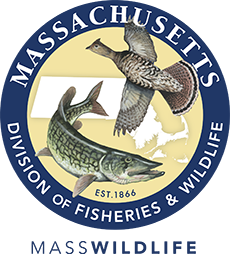- Division of Fisheries and Wildlife
Media Contact
Media Contact, MassWildlife

Adult female deer, called does, typically give birth to 1–3 baby fawns each year. Most are born in May and June; however, fawns can be born in Massachusetts any time between April and September. Healthy fawns weigh about 4-9 pounds at birth and can walk within an hour. During their first couple of months, fawns spend most of their time away from their mothers. This separation protects the fawns, who are not yet strong enough to flee from predators that may be attracted to the mother. Let’s take a closer look at the normal phases of fawn and doe behavior:
Bed Phase (May – June)
The bed phase lasts for the first 5–8 days of a fawn’s life (see photo above). Newborn fawns spend most of this time bedded on the ground alone laying very still even when a person or animal comes near. The mother visits very briefly only a couple times a day to feed the fawn and move it to a new location. If humans or pets are around, most does stay away from their fawn to avoid drawing attention to its location and return when the threat has passed. Does keep twins and triplets apart so if a predator finds one, they will not find the others. If a fawn is threatened, it may drop its head, flatten its ears, and even suspend its breathing. This behavior helps the fawn avoid being detected by predators. While fawns may seem like they are most vulnerable during this stage, it is actually the lowest risk phase for predation.
Flush Phase (May – June)
The flush phase is the first approximately 8–30 days of a fawn’s life. Fawns still spend most of their time bedded on the ground alone receiving brief, infrequent visits from their mother. During this phase, fawns lay still until a threat is close and then quickly run—or “flush”—to a new spot and bed down to hide. They may make crying or bleating sounds when they are disturbed by people or when trying to locate their mother.
BE WILDLIFE SMART: During the bed and flush phases, people sometimes find what they think is an abandoned fawn and attempt to remove it from the wild. While this is well intentioned, it is harmful to the fawn. It is also illegal to possess or capture a fawn. If you find a fawn, the best thing you can do is leave it alone. The mother is likely nearby and continuing to check on the fawn. During these phases, there can be increased risk of conflict between does and dogs when does try to protect their fawns that are hidden nearby. Pet owners can reduce risk of conflict by leashing their dogs and keeping them close by when deer are in the area.
Active Phase (July – August)
Active phase begins after a fawn is about 30 days old. During this time, fawns are strong enough to flee from predators and are seen more frequently as they start exploring their environment. Fawns begin to spend more time with their mothers and siblings during this period.
BE WILDLIFE SMART: During the active phase, people often see fawns and their mothers near their homes and neighborhoods. Do your part to keep fawns and adult deer wild! Never intentionally feed wildlife and observe at a respectful distance.
What to do if you find a fawn:
- Leave the fawn alone, even if the mother is not in sight. The mother is likely nearby and visiting her fawn when she doesn’t feel threatened. This behavior helps the fawn avoid being detected by predators.
- If you have taken a fawn into your care, you should immediately return it where you found it, or in safe cover nearby. Then, quickly leave the area so the fawn does not follow you and the mother can return. The mother will return to nurse the fawn even if it has been handled by people. Do not try to feed fawns as they have sensitive stomachs.
- It is illegal for any member of the public to possess a deer fawn for any reason.
- If a fawn is visibly injured or found with its dead mother, call MassWildlife at 508-389-6300 or the MA Environmental Police at (800) 632-8075. In the rare situation where rehabilitation is needed, care for fawns will be coordinated by MassWildlife.
